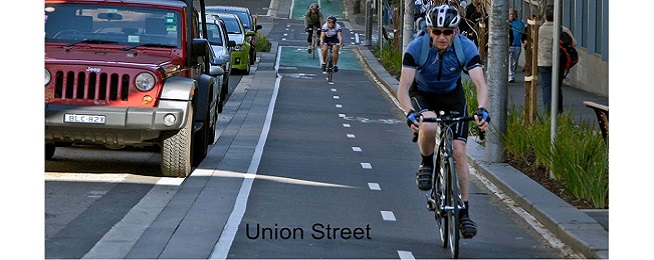The City of Sydney’s head of Cycling Strategy, Fiona Campbell, was a big hit at the recent Bike Futures seminar, showing how separated cycleways could be retrofitted into old city streets.
Sydney now has almost 13 km of separated cycleways, despite having virtually no bicycle facilities before 2009, and it has plans for many more.
It has worked with ten neighbouring councils to put together a proposal that has been endorsed by Infrastructure Australia, which would create a 191 km cycling network within 10 km of the city centre.
Fiona described the cycle network as being this century's new public health infrastructure, not dissimilar to drainage and sewerage systems built in post-industrialised cities in the 1900s.
The network is based on the rule of thumb that most people don’t want to travel more than 30 minutes to get to their destination and that 10 km is about the distance of a 30 minute ride.
Some 1.2 million people live within 10 km of Sydney Town Hall.
Why separation
Like Hobart’s recent city vision exercise, Sydney residents decided they wanted “a city for pedestrians and cyclists” in their 2030 strategic directions plan.
When Sydney was developing its 2007 cycling strategy it surveyed potential and infrequent riders and found 84% wanted bicycle infrastructure separated from traffic.
It then embarked on planning for separated cycleways that would cater to the majority of the population rather than the hardy couple of per cent who currently ride.
Design challenges
As an older city there have been some challenges in retrofitting cycleways into existing streets.
This means there are some facilities that do the job but are not ideal. This includes some of the 2.4 metre wide bi-directional cycleways that have been squeezed into residential streets to ensure parking is not affected.
City centre and industrial areas have proved easier to design as parking on one side is taken away to make way for the cycleway, as there is plenty of off-street parking.
Sydney has been able to improve on the infrastructure it has with a couple of tweaks at potential collision points. Where they can, they raise intersection crossings to slow cars down and/or bend the bike lane at intersections to give cars room to turn and wait for bicycles to cross.
Where possible, cycleways are raised from the road surface to be flush with the footpath or slightly lower. This creates a kerb barrier to vehicles rather than having to install a concrete buffered area.
Rider numbers up
The City’s strategy has worked, with the number of bicycle trips counted in the morning and evening peaks doubling in the past seven years.
On the routes where separated cycleways have been installed the results are staggering. All of the nine routes have experienced over 300% increases in rider numbers in the past seven years and the Kent–Druitt Street route has gone up by 645%.
The City is now consulting with the community on a refresh of its cycling strategy, to set a target of 10% of all trips by bicycle by 2030.
While separated facilities have been the driver for increased ridership, Sydney’s cycling strategy also focuses on bike parking and end-of-trip facilities, community education and awareness programs, and encouragement.
The City has set up the Sydney Cycleways unit to concentrate on getting more people riding and spreading the word about the how and why of cycling.


